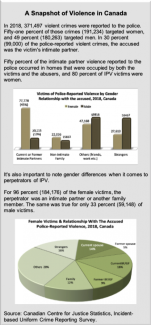Authors: Nisha Malhotra (PhD, School of Economics, UBC) & Karen Mason (Co-Founder, SOAR)
Every day, headlines of violence broadcast news from around the globe. The stories occur in different locations and different cultures, with different perpetrators, but many have one thing in common: women are the victims. Since much of the world went on lockdown in an effort to slow the spread and devastation of COVID-19, global reports indicate that women are increasingly being abused and killed and thus are bearing the brunt of this pandemic as they self-isolate in an effort to flatten the curve for us all.
Violence against women is not new. It's already rampant in Canada—three in ten women have been sexually assaulted at least once since the age of 15, and a woman or girl is killed violently every two-and-a-half-days, most often by a male partner or a family member. The pandemic has shone a light on this global health crisis and brought the discussion of women’s rights to a safe environment to the forefront. Canada identified its first case of COVID-19 on January 25, 2020. By the end of March, all provinces had declared a state of emergency. Businesses, schools, offices, stores, and daycare facilities shut down, and measures to physically isolate people within their homes quickly became the norm. These measures forced individuals to stay in physically-bound spaces with their family members during these highly stressful conditions. Homes are unsafe for most victims of partner violence, and social distancing does not distance victims from their abusers, particularly when they already live together. In 2018, 50% of intimate partner violence reported to police occurred in homes occupied by both the victims and the abusers. A lockdown requiring victims to spend longer hours in proximity to their abuser is likely to increase the frequency and intensity of violent episodes. And since 80% of victims of intimate partner violence in Canada are women, they face a disproportionately higher impact of measures taken during a pandemic.
Physical and social distancing disconnect victims from their support networks such as friends and grassroots organizations, many of which are operating at reduced capacity. There is also a loss of community support that might have helped a potential perpetrator from committing a violent crime. A rise in incidents of intimate partner violence is not a surprise when these factors are coupled with stressors of financial insecurity and job loss caused by the pandemic. In fact, numerous studies have shown that natural disasters and pandemics lead to an increase of these risk factors.
"Pandemics and health emergencies, including SARS, Swine Flu, and influenza, have been associated with problematic coping behaviours, anxiety, suicide attempts and mental health disorders, including post-traumatic stress and depressive disorders, with quarantines, social isolation and limitations on freedom as possible contributing factors." (Peterman et al., 2020, p 9)
While the COVID-19 pandemic is no excuse for such crimes, it is certainly providing the context in which existing violence can fester, worsen, and explode.
Shutdowns and Economic Downturns
With non-essential services shut down during the pandemic many families have to take on the additional work of caring for children and other family members while concurrently working from home and fulfilling other regular household responsibilities. Others found themselves unemployed and dealing with the financial and emotional impacts of being laid off, while also trying to navigate the unknowns of this unprecedented situation. An economic and financial downturn is inevitable during a pandemic, as manufacturing and services shut down, supply-chains breakdown, international trade falls, and the economy contracts. The recession not only leads to salary cuts and unemployment, but also increases the likelihood that job losses will continue into the future. Uncertainty about the future, coupled with increased food insecurity and poverty, exacerbate stressors known to contribute to domestic violence.
Essential Intoxication
The above stressors can also increase reliance on drugs and alcohol. This reality is particularly worrying given that a large body of research (as well as a wide array of anecdotal evidence) suggests that increased alcohol consumption leads to a higher likelihood of violence and abuse. The sale of alcohol was declared an essential service in much of Canada during the lockdown and a recent poll showed that 25% of Canadians between the ages of 35-54 and 21% of 18-34-year-olds reported drinking more alcohol at home. Similar results were reported from a crowd-sourced survey conducted in Ontario during the lockdown. This poll discovered that 70% of those that changed their drinking behaviour indicated they had increased drinking since the start of COVID-19.
In 1994, The Supreme Court of Canada acquitted a man who sexually assaulted a disabled woman. Drunkenness was used to excuse his actions. The Charter of Rights was invoked to justify intoxication as a defence for the abuser in a majority ruling (6-3). Sadly, the Henri Daviault case was not an exception. In light of other such cases, the government passed a law disallowing extreme intoxication as a defence for violent crimes. Yet on June 3, 2020 Ontario's Court of Appeal allowed an individual accused of sexual assault to use extreme intoxication in their defence, declaring it a constitutional right. When courts refuse to convict people who violently attack people after willingly and knowingly intoxicating themselves, violence is even more likely to rise—especially when alcohol is deemed a necessity during a stressful pandemic. Sadly, the majority of people accused of domestic violence are male and the majority of victims are female. Furthermore, according to the 2018 Canadian Health survey, males are more likely to report heavy drinking (23.5%) compared to females (14.8%). If intoxication is allowed as a defence for violent crimes, it undermines a woman’s rights to safety and justice.
What now?
On March 18, 2020 the federal government announced $50 million to support the sector working to end violence against women. Of this, up to $26 million was dedicated as emergency funding to support eligible shelters and transition houses. These are important, and necessary, steps. However, more is needed to address the existing epidemic of violence against women and prepare for the challenges still to come. Women's groups and advocates, such as NUPGE, have been calling for a national action plan on violence against women and gender-based violence since 2015—yet it still does not exist. And our legal system makes it harder for survivors of sexual assault and violent crimes to get justice by allowing extreme intoxication to be considered a legitimate defense against such violent crimes.
In its report “COVID-19 and Ending Violence Against Women and Girls” the United Nations urges countries across the world to form national responses. They encourage nations to include plans for increasing and adapting funding programs and support for essential services such as shelters, hotlines and online counselling services. This may include the provision of psychosocial support for women and girls directly affected by intimate partner violence and for frontline staff who often suffer vicarious trauma. Furthermore, they highlight the need for governments to prioritize training for front line workers about intimate partner violence and to ensure strong, timely action is taken by law enforcement on cases of violence against women and girls.
And there’s still more that can be done. Canada needs to ensure that there are pandemic-safe housing options in place as alternatives to already-overburdened shelters. A financial aid program needs to be formalized to reduce victims’ dependence on their abuser. And more resources relating to family courts during and after a health crisis need to be provided. The experts agree a second wave of the COVID-19 pandemic IS coming. While on that it seems there is no question, one question remains: when it comes to keeping women and girls safe, will we be ready?
*If you feel unsafe in your home or relationship and need support, visit www.sheltersafe.ca for resources across Canada. If you are in immediate danger, call 911*
References
Abramsky, T., Watts, C.H., Garcia-Moreno, C. et al. (2011). What factors are associated with recent intimate partner violence? findings from the WHO multi-country study on women's health and domestic violence. BMC Public Health 11, 109.
Canadian Department of Justice. (2009). An estimation of the economic impact of spousal violence in Canada. Available: http://www.justice.gc.ca/eng/rp-pr/cj-jp/fv-vf/rr12_7/p0.html - sum
Devries, K. M., Mak, J. Y., Garcia-Moreno, C. Petzold, M., Child, J.C., Falder, G. et al. (2013). The global prevalence of intimate partner violence against women. Science 340(6140): 1527–8.
Eckhardt, Christopher I., et al. (2015). Mechanisms of alcohol-facilitated intimate partner violence. Violence Against Women 21(8).
Fuller-Thomson, E., Baird, S. L., Dhrodia, R. & Brennenstuhl, S. (2016). The association between adverse childhood experiences (ACEs) and suicide attempts in a population-based study. Child: Care, Health and Development. DOI: 10.1111/cch.12351
ISPCAN. (2020). Behind closed doors measuring family violence in the context of COVID 19 in Canada. Retrived from: https://www.youtube.com/watch?v=5YVLFl8l0mM&feature=youtu.be
Peterman A, Potts A, O'Donnell M, Thompson K, Shah N, Oertelt-Prigione S, van Gelder N. Pandemics and violence against women and children. Center for Global Development working paper. 2020, April 1:528.
Statistics Canada. (2018). Family violence in Canada: A statistical profile, 2018. Retrieved from: https://www150.statcan.gc.ca/n1/pub/85-002-x/2019001/article/00018-eng.htm
Unicef. (2006). Behind closed doors: The impact of domestic violence on children. Available: http://www.unicef.org/protection/files/BehindClosedDoors.pdf

